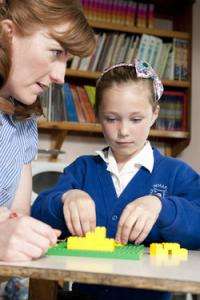Is Model-Making Really Child's Play?

(PhysOrg.com) -- Children are stalled by the same thinking processes as adults when they assemble models, according to new research.
Experiments to study the actions of children as they build a series of models using LEGO bricks, are being conducted by University of Derby psychologist Dr Miles Richardson.
Dr Richardson, whose work is set to feature in a forthcoming edition of Applied Cognitive Psychology, suggests a greater understanding of how children approach construction tasks could help boost their development in maths and science.
In the study, he suggests four factors - the variety and number of blocks needed to complete the task, symmetry of the blocks and the number of spare blocks - all play a part in assessing how easy or hard children find it to complete models.
Dr Richardson has found the issues affecting children building LEGO models to be the same as those that affect adults when they build flat-pack furniture kits. They match a formula he previously developed to determine the ease of assembly for such products for frustrated DIYers. The formula was also good at predicting children's LEGO building performance.
Dr Richardson said: "Construction tasks form a major part of children's play and can be linked to achievement in maths and science.
"However, there is a lack of understanding of construction task ability and development.
"Given the breadth of construction from infants' play using things like LEGO bricks, to adults building self-assembly products, the lack of understanding of its development is surprising."
Dr Richardson says this research is of interest to educators and developmental psychologists as construction play provides an excellent opportunity to help identify children who might struggle academically, enabling measures to be taken in intervening years.
He said: "Our research shows that exactly the same challenges that affect adults during the construction also affect children, just to a different level.
"Greater understanding of the characteristics of construction tasks, and how children's ability is mediated by cognitive factors can inform curriculum development."
During the study, children aged seven to eight and ten to eleven were timed and observed as they built a series of seven models using LEGO bricks. Items included a chair, sun bed and a table, and children had a picture of the completed model and a diagram showing how each brick was put together. Every child completed the task successfully, but with varying times taken to reach completion.
The initial research involved children at Etwall Primary School, in Etwall, Derbyshire, and further studies are now being conducted with children, including an older age group involving two more schools, Granville Community School in Woodville, Swadlincote, and John of Rolleston Primary School in Rolleston-on-Dove, Staffordshire.
Etwall Primary School Head Teacher Janet Meakin said: "The children have been proud to be part of the research project and it was fascinating to watch them as they worked on the tasks."
Early indications suggest the older the child, the quicker they complete the model-making task. However again, children are challenged by the same aspects as the adults in the flat-pack furniture study, particularly with the variety and symmetry of component parts.
Dr Richardson has been able to conduct the research thanks to funds from the University's Research Inspired Curriculum Fund, and with support from research assistant Caroline Jordan, who is studying for a Masters in Health Psychology at Derby.
In Dr Richardson's previous study with adults, he identified four characteristics common to all self-assembly products, then monitored people grappling with the intricacies of furniture kits to see how long they took to complete the task.
The results showed how each of the characteristics affected difficulty of assembly. This could be used in a formula to distinguish easy kits from more baffling ones.














